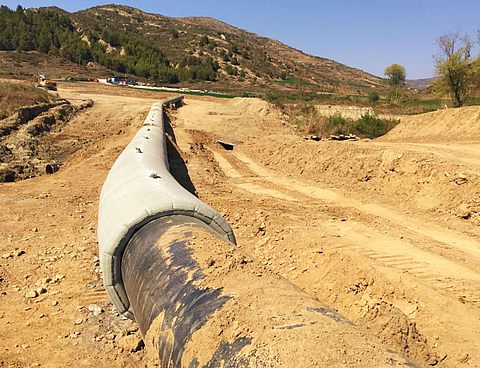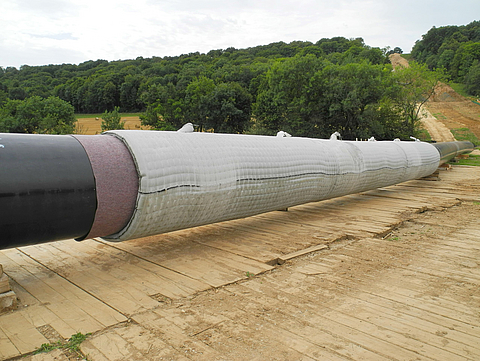| Author: Jack Christmas | Date of publication: June 20, 2023 |
Comparing Incomat Pipeline Cover (IPC) and Geotextile Pipe Weights (GPW)
Pipeline protection is essential to ensure durability and prevent costly damages. Both Geotextile Pipeline Weights (GPW) and Incomat Pipeline Cover (IPC) offer different benefits in terms of UV inhibitors and high impact resistance. This section will explore the advantages of each option in these areas.
UV Inhibitors in Geotextile Pipeline Weights
Geotextile Pipeline Weights are designed using high-grade, woven non-coated geotextiles, which are resistant to the harmful effects of ultraviolet (UV) radiation. Prolonged exposure to UV can weaken the fabrics, making them more susceptible to damage and failure. The UV inhibitors in GPW help protect pipelines by minimizing the deterioration caused by UV exposure.
UV Inhibitors in Incomat Pipeline Cover
The IPC also provides protection against UV exposure, although the fabric is considered a “lost formwork” until the concrete has cured within. The high-density polyethylene (PE) and polyamide (PA) material used in IPC inherently offers UV resistance. While not as specifically focused on UV protection as GPW, IPC still provides a reliable defense against the damaging effects of UV radiation on pipelines.
Comparing UV Inhibitors in GPW and IPC
Both GPW and IPC provide UV protection for pipelines, with GPW having a more prominent focus on UV inhibitors. IPC is comprised of a UV resistant material but may not be as specialized in UV protection as GPW as its main function is to provide a formwork for the concrete. Ultimately, the choice between the two will depend on the specific requirements of the pipeline project and the level of UV exposure expected.
High Impact Resistance in Geotextile Pipeline Weights
Geotextile Pipeline Weights offer a certain degree of impact resistance due to their construction from woven geotextiles and aggregate fill material. While GPW can provide some protection against impact damage, it may not be as robust as IPC in this regard.
High Impact Resistance in Incomat Pipeline Cover
IPC excels in providing high impact resistance for pipelines. The concrete fill material used in IPC ensures that the pipeline remains protected from potential impact damage during installation, maintenance, or in environments where impact hazards may be present.
Comparing High Impact Resistance in GPW and IPC
When comparing the impact resistance offered by GPW and IPC, IPC has a clear advantage. The fill material provides superior impact resistance, making IPC better suited for environments where pipelines may be exposed to potential impact hazards. In contrast, GPW offers some level of impact resistance, but it is not as strong as IPC. The choice between the two will depend on the specific fill material, the needs of the pipeline project and the expected exposure to impact hazards.
The process of preparing and installing pipeline protection systems is crucial to the success of any pipeline project. In this section, we will compare the steps involved in preparing and installing Geotextile Pipeline Weights (GPW) and Incomat Pipeline Cover (IPC) along the right of way.
Preparing and Installing Geotextile Pipeline Weights
Geotextile Pipeline Weights can be prepared along the right of way, making them an efficient choice for pipeline projects. The following steps are involved in the installation of GPW:
- Excavation: A trench is dug to accommodate the pipeline and the geotextile weights.
- Filling Geotextile: The geotextile material is filled with local aggregate, sand, or gravel and laid along the bottom of the trench, with the pipeline placed on top either filled by hand or using a filling frame.
- Weight Placement: The pipeline weights are positioned over the pipeline, ensuring proper coverage and protection.
- Backfilling: The trench is backfilled with the appropriate material, covering the pipeline and weights to secure them in place.
Preparing and Installing Incomat Pipeline Cover
The Incomat Pipeline Cover, which can also be prepared along the right of way, offers an even higher level of protection than GPW, while maintaining similar efficiency. The installation process for IPC includes:
- Excavation: A trench is dug to the desired depth, considering the diameter of the pipeline and the IPC.
- Filling IPC: The IPC is zipped around the pipeline and filled with highly fluid concrete through the flexible fill inlets.
- Pipeline Placement: The pipeline can either be placed into the trench prior to filling the IPC formwork and filled in place, or after the concrete has cured within the fabric formwork. The Incomat Pipeline Cover is capable of being filled in-situ during water crossings or marsh crossings.
- Backfilling: The trench is then backfilled with the appropriate material, covering the pipeline and IPC.
Comparing the Preparation and Installation of GPW and IPC
Both GPW and IPC can be prepared along the right of way, offering efficient installation processes. The key differences between the two methods include the placement of the pipeline in relation to the protective material and the method of securing the protection in place. GPW requires the use of on-site filling frames or by hand prior to placement on the pipeline. IPC, on the other hand, is wrapped around the pipeline prior to filling, providing options to fill the pipeline protection in place or prior to placing it in the trench.
The choice between GPW and IPC will depend on the specific needs of the pipeline project, as well as factors such as environmental conditions, accessibility, and project timeline.
Transportation and installation play a significant role in the success and efficiency of pipeline projects. In this section, we will compare the logistical advantages of Incomat Pipeline Cover (IPC) and Geotextile Pipeline Weights (GPW) in terms of transportation and installation.
Transportation and Installation of Geotextile Pipeline Weights
Geotextile Pipeline Weights have several advantages when it comes to transportation and installation:
- Lightweight: The geotextile material is relatively lightweight, making it easier to transport to the job site.
- Compact: GPW can be folded and stacked prior to filling, reducing the space required for transportation and storage.
- Reduced Installation Time: The installation process is streamlined using fill frames, and the geotextile material can be positioned as needed.
Transportation and Installation of Incomat Pipeline Cover
IPC also boasts logistical advantages in terms of transportation and installation:
- Lightweight: IPC is made of lightweight materials, facilitating ease of transportation.
- Compact: The IPC prefabricated panels are easily folded and stacked, which saves space during transportation and storage.
- Quick Installation: The IPC installation process is designed for efficiency, with the cover being wrapped around the pipeline and secured in place.
Comparing the Logistical Advantages of GPW and IPC
Both GPW and IPC provide logistical advantages in terms of transportation and installation, given their lightweight and compact nature which makes them convenient to transport and store. While both systems' installation processes are designed for efficiency to minimize time and labor required on site, IPC holds a slight edge in this regard.
The selection between GPW and IPC will rely on the specific requirements of the pipeline project, taking into account factors such as environmental conditions, site accessibility, and the project timeline. IPC, with its slight advantage, might be the preferable choice in certain scenarios, but both options provide benefits that can significantly contribute to the overall success of the project.
The depth of trenches required for pipeline installation can have a significant impact on the environment and excavation costs. In this section, we will discuss how Geotextile Pipeline Weights (GPW) and Incomat Pipeline Cover (IPC) contribute to shallower trench depths, benefiting both the environment and reducing excavation efforts.
Geotextile Pipeline Weights and Shallower Trench Depth
Geotextile Pipeline Weights offer the following advantages in terms of trench depth:
- Flexible Design: The geotextile material can conform to the shape of the pipeline, allowing for a more compact trench.
- Load Distribution: GPW provides even load distribution, minimizing the depth required for trench stability.
- Less Soil Disturbance: With shallow trenches, there is less soil disturbance, which reduces the environmental impact of the excavation.
Incomat Pipeline Cover and Shallower Trench Depth
IPC also contributes to shallower trench depths through:
- Customization: IPC can be prefabricated to fit the pipeline diameter, allowing for a more compact trench design.
- Load Distribution: IPC provides even load distribution, which reduces the depth required for trench stability.
- Minimized Excavation: The IPC design requires less excavation, resulting in reduced environmental impact.
Comparing the Benefits of GPW and IPC in Trench Depth
Both GPW and IPC contribute to shallower trench depths, providing benefits to the environment and reducing excavation efforts. The flexible design of GPW and the superior customization of IPC allow for more compact trenches, reducing soil disturbance and excavation needs. IPC's customization options provide a slight advantage, particularly when intricate or specific designs are required.
The choice between GPW and IPC will largely depend on the specific needs of the pipeline project, taking into account factors such as pipeline diameter, site conditions, and environmental regulations. Although both options can lead to more sustainable and cost-effective pipeline installations, the enhanced customization of IPC may offer a slightly more optimal solution in certain contexts.
Pipeline installations often involve navigating bends and complex geometries, which require flexible solutions to ensure proper support and protection. In this section, we will evaluate the flexibility of Geotextile Pipeline Weights (GPW) and Incomat Pipeline Cover (IPC) in handling these challenging conditions.
Flexibility of Incomat Pipeline Cover
IPC provides a high degree of flexibility for pipeline installations:
- Versatile Design: IPC can be prefabricated to fit pipeline diameters, bends, and complex geometries, ensuring a secure fit and proper support.
- Easy Installation on Bends: IPC can be prefabricated into smaller panels to allow for easy installation on bends and in complex terrains without the need for specialized equipment or techniques.
- Straightforward Filling Process: The flexible fill inlets utilized in the Incomat Pipeline Cover panel designs allow for rapid filling of all panel sizes.
Flexibility of Geotextile Pipeline Weights
Geotextile Pipeline Weights also offers flexibility for pipeline installations:
- Adaptable Design: The flexible geotextile fabric can easily conform to the pipeline's shape and accommodate various diameters, bends and complex geometries.
- Customization: GPWs can be tailored to fit specific project requirements, ensuring proper support for pipelines in diverse situations.
- No Need for Specialized Equipment: GPWs can be installed using standard equipment and techniques, simplifying the installation process, even in challenging terrain.
Comparing the Flexibility of GPW and IPC in Pipeline Installations
Both Geotextile Pipeline Weights and IPC provide flexible solutions for pipeline installations with bends and complex geometries. While GPWs offer a highly adaptable design and customization options, and can be installed without specialized equipment, IPC slightly edges it out with its versatile prefabrication, easy installation on bends, and a straightforward filling process.
The decision between GPW and IPC rests on the specific needs of a pipeline project, including considerations such as the pipeline material, environmental conditions, and project constraints. Though both choices offer flexible solutions capable of handling challenging installation conditions and ensuring appropriate support and protection for pipelines, the versatility and ease of installation associated with IPC could make it the slightly more advantageous choice in certain situations.
In the competitive world of pipeline construction, time and cost savings are crucial factors. Prefabrication and reduced labor can provide significant advantages in both areas. In this section, we will compare the time and cost-saving benefits of Geotextile Pipeline Weights (GPW) and Incomat Pipeline Cover (IPC).
Prefabrication and Labor Reduction with Geotextile Pipeline Weights Geotextile Pipeline Weights offer some time and cost-saving benefits:
- Offsite Manufacturing: GPWs can be manufactured off site and transported to the project location, streamlining the installation process.
- Easy Installation: The lightweight and flexible design of GPWs enables easy installation, reducing labor costs and installation time.
- Reduced Equipment Needs: GPWs can be installed using standard equipment, eliminating the need for specialized tools or machinery.
Prefabrication and Labor Reduction with Incomat Pipeline Cover
IPC also provides time and cost-saving advantages:
- Prefabricated to Fit: IPCs are prefabricated to fit the specific pipeline diameter, reducing on-site modifications and labor-intensive adjustments.
- Quick Installation: IPC's design allows for a faster installation process, saving both time and labor costs.
- No Specialized Equipment Required: Like GPWs, IPC can be installed using standard equipment, eliminating the need for specialized tools or machinery.
Comparing Time and Cost-saving Advantages of GPW and IPC
Both Geotextile Pipeline Weights and Incomat Pipeline Cover offer valuable time and cost-saving benefits through prefabrication and labor reduction.
GPWs do provide offsite manufacturing, easy installation, and reduced equipment needs. However, IPC goes a step further, offering prefabrication tailored specifically to fit varying pipeline diameters, quicker installation, and the added advantage of eliminating the need for specialized equipment.
Although both options deliver significant time and cost-saving benefits, the choice between GPW and IPC will be influenced by the specific project requirements and priorities. Factors such as pipeline material, environmental conditions, and project constraints should be carefully considered.
While both options hold merit, IPC may offer a slight edge in optimizing time and cost efficiency in pipeline construction projects, thanks to its tailored prefabrication and elimination of specialized equipment requirements.

Jack Christmas
Author
As Hydraulic Product Manager for HUESKER North America, Jack Christmas leads in the execution of design, product development, and sales strategies throughout various waterborne applications. He has extensive experience in designing solutions utilizing geosynthetics for Berth & Scour, Sludge Dewatering, Coastal Protection, and Buoyancy and Uplift Protection in Pipelines. Jack received a B.S. in Civil Engineering from Louisiana State University and currently has extensive experience providing product recommendations throughout North America.
If you are interested in having more information about our Incomat Pipeline Cover, contact Jack Christmas.









